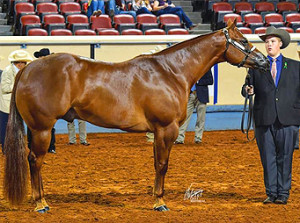Achieving the Perfect Set-Up with John Shepard
Click here to read the complete article178 – March/April, 2018
BY RACHEL KOOIKER
 In the center of the arena, a horse stands at attention like a statue. Your eye is drawn to the powerful animal as you take in its exquisite profile. Short, fox-like ears are pointed forward on an alert, expressive head. Power and poise are captured like roped lightning at the end of a lead rope, and yet the animal is statue-still and elegant, with muscles taut.
In the center of the arena, a horse stands at attention like a statue. Your eye is drawn to the powerful animal as you take in its exquisite profile. Short, fox-like ears are pointed forward on an alert, expressive head. Power and poise are captured like roped lightning at the end of a lead rope, and yet the animal is statue-still and elegant, with muscles taut.
If it seems like getting a Halter horse into perfect position is mostly luck, it’s not. Halter is an event where judges are tasked with finding the most desirable individual. Keeping that in mind, the most important job of the Halter exhibitor is to efficiently set up a horse in a manner that best showcases its conformation. We sat down with WCHA judge and trainer, John Shepard, for a close inspection of this process.
John Shepard, of Holly Glen Farm in Harrington, Delaware has raised, conditioned, and shown multiple All American Quarter Horse Congress Champions in open, amateur, and youth competition, as well as multiple Congress Grand and Reserve Champions, an APHA World Champion Halter Stallion, and multiple ApHC, PHBA, and ABRA World and Reserve World Champions, and year-end High-Point Halter winners. According to Shepard, the process of perfecting the set-up begins with training basics.
WHOA IS FIRST
Shepard begins by teaching horses the importance of the word, whoa. “For any horse- young, old, green, or untrained- the first thing is that they need to know the word, whoa. With young horses, we start with babies by just picking their feet up a lot and teaching them it’s okay to be handled. As we move forward, we’re going to move into setting them up, first by hand, and then off of the halter.” From the start, Shepard advises handlers to set the opposite foot first and to start with the hind feet. Start with the right hind foot and then the left. Next, set the right front foot and then the left. Shepard elaborates on this process. “I want to keep their attention in the beginning. A young one might not have the mindset for that yet, so we might start with a chain under the chin. Then, begin by walking them forward and walking them into the set-up. The first foot is on the passenger side (the side opposite the handler). Then, work from the halter or chain to move the left rear foot. Kiss to put the foot back, and cluck to move the foot forward. Once we get that ‘driver side’ set, then we put our hand on the wither to pull on the wither a little and touch the foot. You can teach your horse to respond to a kiss or cluck. Whatever your cue is, just be consistent,” he says. If at any point your horse moves out of position, use a firm but gentle command of “whoa” and begin setting him up again. The repetition and consistency of going through exactly the same motions each time, in each phase of training, green or very broke, is key to achieving a horse that will know its job and perform it well every time.
Click here to read the complete article178 – March/April, 2018










